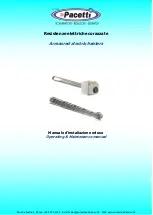
3
Operating Instructions and Owner’s Manual
Enerco | Heatstar ER2STG Tube Series Heater
SECTION 2: Planning
The following codes and instructions should be followed when
planning the installation of the Heatstar ER2STG heater. In
addition to these instructions, the warnings in (Section 1) must
be carefully adhered to since improper installation may lead to
property damage, injury, or death.
National Standards and Applicable
Codes
Gas Codes:
The type of gas appearing on the nameplate must be
the type of gas used. Installation must comply with local
codes and recommendations of the local gas company,
and the National Fuel Gas Code, ANSI Z223.1 – latest
revision, (same as NFPA Bulletin 54) or the Natural Gas
and Propane Installation Code, CSA B149.1.
• Clearance between the heater and its vent and adjacent
combustible material (which is part of the building or its
contents) shall be maintained to conform with the Stan-
dard for Installation of Gas Appliances and Gas Piping,
NFPA-54 /ANSI Z223.1 – latest revision, National Fuel
Gas Code or the Natural Gas and Propane Installation
Code, CSA B149.1.
Aircraft Hangers:
Installation in aircraft hangers must be in accordance
with the Standard for Aircraft Hangers, ANSI / NFPA-
409 – latest revision.
• Heaters in aircraft storage or service areas shall be in-
stalled at a height of 10 feet above the upper surface of
wings or engine enclosures of the highest aircraft which
may be housed in the hanger. (This should be measured
from the bottom of the heater to the wing or engine
enclosure, whichever is highest from the floor.)
• In other sections of aircraft hangers, such as shops or
offices, heaters must not be installed less than 8 feet
above the floor.
• Heaters installed in aircraft hangers shall be located
so as not to be subject to damage by aircraft, cranes,
moveable scaffolding or other objects.
Public Garages:
Installations in garages must be made in accordance
with the Standard for Parking Structures, NFPA-88A –
latest revision or the Standard for Repair Garages, NFPA-
88B – latest revision.
• Heaters must not be installed less than 8 feet above
the floor. Minimum clearances to combustibles must be
maintained from vehicles parked below the heater.
• When installed over hoists, minimum clearances to com-
bustibles must be maintained from the uppermost point
on the hoist.
Venting:
The venting must be installed in accordance to the latest
revision of ANSI Z223.1 or CSA 149.1. Partial informa-
tion with regard to this code is provided in (Section 5) of
this installation manual with regard to size and configu-
rations for venting arrangements.
• Any portion of flue pipe passing through a combus-
tible wall must be dual insulated or have an approved
thimble. Refer to to the latest revision of ANSI Z223.1 or
CSA 149.1
Hazardous Locations:
Where there is the possibility of exposure to combustible
airborne material or vapor, consult the local Fire
Marshal, the fire insurance carrier or other authorities
for approval of the proposed installation.
Critical Considerations
Heatstar ER2STG is a suspended heater. Therefore, its
stability, flexibility, and safety are very important. Before
starting installation, be sure the system can meet the
following requirements.
• For use in indoor or outdoor installation. Not for use in
residential dwellings.
• Maintain specified clearances to combustibles, and safe
distance from the heat-sensitive material, equipment
and work stations.
• The stated clearances to combustibles represent a sur-
face temperature of 90°F (30°C) above room
temperature. Building materials with low heat tolerance(
such as plastic, vinyl siding, canvas, etc.) may be subject
to degradation at lower temperatures. It is the install-
ers responsibility to assure that adjacent materials are
protected from degradation.
• Provide a suspension with vertical length of chain or
swinging rod which has at least 2 inches of horizontal
travel for each burner in a straight run. Be sure the sus-
pension system is sufficiently flexible to accommodate
thermal expansion which occurs as the system heats up
(see Figure 6 on page 11).
• Provide access to burners for servicing, preferable on
both sides, above and behind the burner for removal.
• Provide a minimum of 18 inches of clearance between
burners and building walls. (Always observe minimum
clearances to combustibles.)
• Be sure the heater has a downward pitch of one-half
inch per 20 feet away from the burner.
• Provide signs in storage areas to specify maximum stack-
ing height to maintain required clearances to combus-
tibles.
• Plan location supports
(see Figure 2A-D on page 8).
Locate a support near all elbows.
•
The installation must conform with local building codes
or in the absence of local codes, with the National Fuel
Gas Code, ANSI Z223.1/NFPA 54 or the Natural Gas
and Propane Installation Code, CSA B149.1.
•
If an external electrical source is utilized, the heater,
when installed, must be electrically grounded in accor-
dance with the National Electical Code, ANSI/ NFPA 70
or current Canadian Electrical Code, CSA C22.1.
Available Venting Kits
F102848
Category I 4" Vertical Vent Kit
F102849
Category I 6" Vertical Vent Kit
F102860
Category III 4" Stainless Steel Horizontal Vent
Kit




































